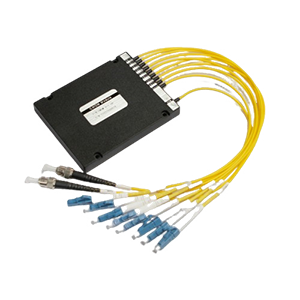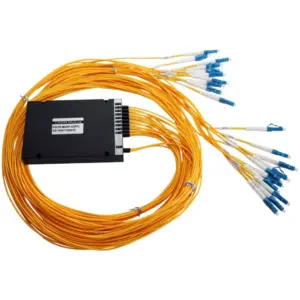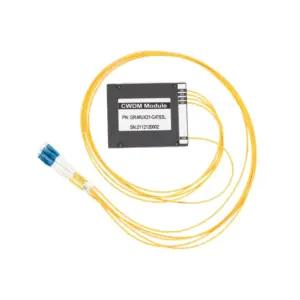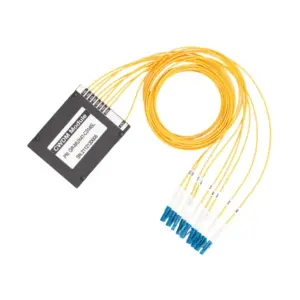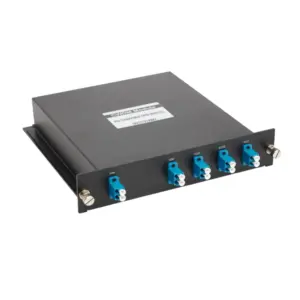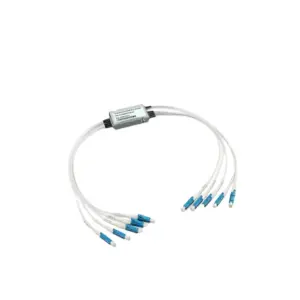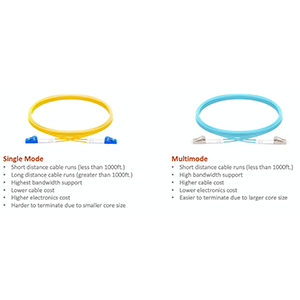Welcome to this blog, I will take you to deeply explore the importance and application of Wavelength Division Multiplexing (WDM for short) in optical communications. By understanding the principles and working methods of WDM, you will understand how to implement high-bandwidth and high-capacity optical communication systems to meet the growing communication needs.
Basic knowledge of optical communications
Optical communication is a communication method that uses optical signals to transmit information. It uses the transmission characteristics of light and optical fiber as the transmission medium to achieve high-speed, large-capacity and long-distance data transmission. Below we review some of the basic principles and components of optical communications.
-
Transmission characteristics of light: Light is an electromagnetic wave with the characteristics of high-speed transmission, low loss and large bandwidth. The propagation speed of optical signals in vacuum is close to the speed of light, and the propagation speed in optical fibers is also very fast. At the same time, the transmission loss of light in optical fibers is relatively low, allowing long-distance signal transmission. In addition, the spectrum width of optical signals is large and can provide large-bandwidth transmission.
Components of optical fiber communication systems: Optical fiber communication systems are composed of multiple components, including light sources, modulators, optical fibers, optical receivers and signal processing equipment.
-
Light source: Light source generates optical signals. Commonly used light sources include lasers and light-emitting diodes, which can generate high-purity and stable optical signals.
-
Modulator: A modulator converts an electrical signal into an optical signal. Commonly used modulation techniques include direct modulation and external modulation. Direct modulation uses current or voltage to directly modulate the output power of the light source, while external modulation achieves signal modulation through the light intensity conversion characteristics of the modulator.
-
Optical fiber: As a transmission medium for optical signals, optical fiber has the characteristics of low loss, large bandwidth and resistance to electromagnetic interference. Optical signals are transmitted through the principle of total reflection in the fiber core, and are protected and guided by the overall structure of the fiber.
-
Optical receiver: An optical receiver receives optical signals and converts them into electrical signals. The optical receiver includes components such as a photodetector and a preamplifier, where the photodetector converts the optical signal into a current or voltage signal, and the preamplifier amplifies and processes the signal.
-
Signal processing equipment: Signal processing equipment processes and demodulates received electrical signals to restore the original information content. This includes steps such as signal amplification, filtering, clock recovery and demodulation.
-
Challenges in traditional communication systems:
In traditional communication systems, bandwidth limitation and spectrum utilization are important challenges. Traditional electrical signal transmission is limited by bandwidth, and as data transmission rates increase, there is a trade-off between transmission distance and bandwidth. In addition, spectrum utilization is also an important issue. Traditional frequency division multiplexing and time division multiplexing technologies have certain limitations in spectrum utilization. These challenges limit the capacity and transmission efficiency of traditional communication systems.
In order to overcome these challenges, optical communication technology came into being. Optical communication utilizes the transmission characteristics of light and the advantages of optical fibers to achieve high-speed, large-capacity and long-distance data transmission. The development and progress of optical communication systems provide feasible solutions to address bandwidth limitations and spectrum utilization.
How WDM works
Wavelength Division Multiplexing (WDM) is a technology that achieves multiplexing by transmitting multiple optical signals of different wavelengths simultaneously in optical fibers. It uses different wavelengths of optical signals to distinguish and transmit multiple independent signals, thereby improving the transmission capacity and efficiency of optical fiber networks.
The basic principle of WDM is to transmit optical signals of different wavelengths on the same optical fiber at the same time and separate them at the receiving end. During the transmission process, the optical signals of each wavelength are independent of each other and will not interfere with each other. The optical receiver at the receiving end selectively receives and demodulates optical signals of specific wavelengths according to different wavelengths, thereby restoring the original information content.
There are two main implementation methods of WDM: Wavelength Division Multiplexing (Wavelength Division Multiplexing) and Dense Wavelength Division Multiplexing (DWDM).
-
Wavelength Division Multiplexing (WDM):
Wavelength division multiplexing achieves multiplexing by transmitting optical signals with different wavelengths in optical fibers. Optical signals of different wavelengths are sent into the optical fiber, where they remain independent of each other and do not interfere during transmission. At the receiving end, optical separation devices such as narrowband filters or gratings are used to separate optical signals of different wavelengths, and then perform photoelectric conversion and signal processing respectively.
-
Dense Wavelength Division Multiplexing (DWDM):
Dense wavelength division multiplexing is a technology that further improves optical fiber transmission capacity based on wavelength division multiplexing. It uses tighter wavelength spacing to transmit more wavelength signals into the fiber. Compared with traditional wavelength division multiplexing, the DWDM system has smaller wavelength intervals and can support more wavelengths. Typically, DWDM systems have wavelength intervals of 0.8 nanometers or less and can transmit dozens or even hundreds of wavelengths simultaneously.
By using DWDM technology, the transmission capacity of optical fiber networks can be greatly improved, achieving hundreds or even thousands of times growth. DWDM systems can also support long-distance optical fiber transmission, allowing optical signals to span thousands of kilometers without losing signal quality.
In general, WDM technology achieves high-density transmission and multiplexing of optical signals by simultaneously transmitting multiple optical signals of different wavelengths in optical fibers. Wavelength division multiplexing and dense wavelength division multiplexing are the two main implementation methods of WDM technology. They play an important role in improving the capacity and transmission distance of optical fiber networks.
WDM system architecture and composition
WDM system is an optical communication system that uses wavelength division multiplexing technology to achieve multiplexing. It consists of multiple components, including optical transmitters, optical receivers, optical fibers, gratings, etc. The function and role of each component are described in detail below.
-
Optical transmitter:
The optical transmitter is a key component in a WDM system. It is used to generate and modulate optical signals and send them into optical fibers. Optical transmitters usually consist of components such as lasers, modulators, and drive circuits. The laser generates high-purity and stable optical signals, the modulator converts the electrical signal into an optical signal, and the driving circuit is used to control the operation of the laser and modulator.
-
Optical Receiver:
The optical receiver is located at the receiving end of the WDM system and is used to receive and demodulate optical signals and convert them into electrical signals. Optical receivers usually consist of components such as photodetectors, preamplifiers, and receiving circuits. The photodetector converts the received optical signal into a current or voltage signal, the preamplifier amplifies and processes the signal, and the receiving circuit is used for signal recovery and demodulation.
-
Fiber optic:
Optical fiber is the transmission medium in WDM system and is used to transmit optical signals. Optical fiber has the characteristics of low loss, large bandwidth and resistance to electromagnetic interference. The optical signal is transmitted in the optical fiber through the principle of total reflection in the fiber core, and the optical signal is protected and guided by the overall structure of the optical fiber. Optical fiber plays a key role in WDM systems, supporting high-speed, large-capacity and long-distance data transmission.
-
Raster:
Gratings are important components in WDM systems and are used to separate and combine optical signals of different wavelengths. Grating is an optical element with periodic refractive index changes that can disperse optical signals into different angles according to different wavelengths. At the transmitting end, the grating separates the optical signals of different wavelengths and sends them into the optical fiber. At the receiving end, the grating recombines the optical signals of different wavelengths and sends them into the optical receiver for demodulation and processing.
In addition to the above components, the WDM system also includes optical power control modules, optical signal processing equipment and network management systems. The optical power control module is used to maintain the balanced transmission power of optical signals of different wavelengths in the optical fiber. Optical signal processing equipment amplifies, filters, and demodulates the received optical signal. The network management system is used to monitor and manage the operating status and performance of the WDM system.
Application fields of WDM
WDM technology is widely used in the field of optical communications. The following are some main application areas:
-
Long distance transmission:
WDM technology plays an important role in long-distance transmission. By utilizing optical signals of different wavelengths for wavelength division multiplexing, WDM systems can transmit multiple independent signals simultaneously, and each signal can have high bandwidth. This allows fiber optic networks to span distances of thousands of kilometers without loss of signal quality. WDM technology is widely used in international and domestic optical fiber communications, supporting long-distance voice, data and video transmission.
-
Data center interconnection:
Data centers often require high-bandwidth and high-capacity communications to meet large-scale data transmission needs. WDM technology can realize data center interconnection by establishing high-speed optical fiber connections between data centers. Optical communications between multiple data centers can use WDM technology for wavelength division multiplexing to transmit large amounts of data simultaneously, improving transmission efficiency and network capacity. This high-capacity communication solution is very important for applications such as cloud computing, big data processing, and distributed storage.
-
Optical Network:
WDM technology plays a key role in optical networks. Optical networks use optical fibers as transmission media and realize multiplexing and wavelength division multiplexing through WDM technology, allowing the network to transmit a large number of independent signals at the same time. Optical networks feature high speed, large capacity, and low latency, and are suitable for various application scenarios, including enterprise networks, metropolitan area networks, and wide area networks. The application of WDM technology enables optical networks to meet the growing demand for data communication and support high-speed, reliable and efficient data transmission.
-
Light sensor network:
WDM technology is also widely used in optical sensor networks. By transmitting light signals of different wavelengths in optical fibers, multiple light sensors can be connected to the same optical fiber and the sensor data can be transmitted to remote monitoring and control systems. This WDM-based optical sensor network can realize real-time monitoring and detection of environment, structure and safety, and is widely used in fields such as industrial control, environmental monitoring and safety monitoring.
It plays an important role in long-distance transmission, data center interconnection, optical networks and optical sensor networks. The application of WDM technology enables optical communication systems to achieve high-bandwidth and high-capacity communications, meet the growing demand for data transmission, and promote the development and innovation of information and communication technology.
Performance indicators and optimization of WDM system
Key indicators for evaluating WDM system performance mainly include bandwidth utilization, wavelength spacing and bit error rate. The following introduces these indicators and shares some methods for optimizing WDM system performance.
-
Bandwidth utilization:
Bandwidth utilization is a measure of the effective utilization of optical fiber bandwidth by a WDM system. It represents the ratio of actual transmitted data traffic to available bandwidth. High bandwidth utilization means that the system can use optical fiber resources more effectively and improve the efficiency of data transmission. Bandwidth utilization can be improved by increasing the number of wavelength division multiplexed channels, increasing the transmission rate of each channel, or using more advanced modulation and demodulation techniques.
-
Wavelength interval:
The wavelength interval refers to the wavelength interval between adjacent wavelength division multiplexing channels. It plays an important role in determining the number of channels and spectrum utilization efficiency in WDM systems. Smaller wavelength spacing enables higher channel density, but also increases crosstalk and nonlinear effects between channels. Therefore, signal quality and system complexity need to be considered when selecting wavelength spacing.
-
Bit error rate:
The bit error rate is an indicator of the transmission quality of the WDM system. It represents the proportion of errors in the demodulated signal at the receiving end. A lower bit error rate means that the system transmission is more reliable and can provide high-quality data transmission. Methods to reduce the bit error rate include enhancing the transmission power of optical signals, improving modulation and demodulation technology, reducing nonlinear effects and optimizing the sensitivity of the receiving end.
There are many ways to optimize WDM system performance, the following are two common methods:
-
Wavelength routing:
Wavelength routing is a method to optimize the performance of WDM systems by selecting the best path and wavelength to achieve efficient transmission of optical signals. In wavelength routing, an optical signal selects an appropriate wavelength and transmission path based on its destination and network topology. This can avoid conflicts and interference and improve the efficiency and reliability of signal transmission.
-
Optical signal amplification:
Optical signal amplification is a method of enhancing signal quality and transmission distance. In WDM systems, optical signals are attenuated and lost during transmission, resulting in signal quality degradation. By using an optical amplifier to amplify the signal, the strength and quality of the signal can be improved and the transmission distance can be extended. Commonly used optical amplifiers include fiber amplifiers and semiconductor optical amplifiers.
In addition to the above methods, there are other strategies for optimizing WDM system performance, such as optimizing optical fiber losses and nonlinear effects, using advanced modulation formats and demodulation technologies, using forward error correction coding and flexible optical network management, etc. . The comprehensive application of these methods can improve the performance and reliability of WDM systems and meet the growing data transmission needs.
Summary:
Thank you for reading this blog. I hope you will have a deeper understanding of the importance and application of Wavelength Division Multiplexing (WDM for short) in optical communications. WDM technology realizes high-bandwidth and high-capacity optical communication systems by transmitting multiple optical signals of different wavelengths simultaneously in optical fibers.Effectively solves the challenges of bandwidth limitation and spectrum utilization in traditional communication systems.
If you are looking for reliable high-bandwidth, high-capacity communications solutions, consider using WDM technology. It will bring huge improvements to your communication network and meet your growing communication needs. By choosing our products, you will receive advanced WDM technical support to achieve faster and more reliable communication connections.
WDM FAQ
Lorem ipsum dolor sit amet, consectetur adipiscing elit, sed do eiusmod tempor incididunt ut labore et dolore magna aliqua. Ut enim ad minim veniam, quis nostrud exercitation ullamco laboris nisi ut aliquip ex ea commodo consequat.
Lorem ipsum dolor sit amet, consectetur adipiscing elit, sed do eiusmod tempor incididunt ut labore et dolore magna aliqua. Ut enim ad minim veniam, quis nostrud exercitation ullamco laboris nisi ut aliquip ex ea commodo consequat.

